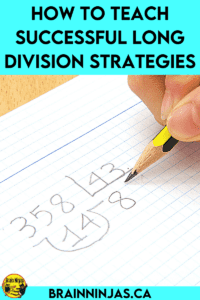
Long division has long been one of the most challenging concepts for students in Grade 4 and Grade 5 to master. There are a few reasons students struggle with long division, so we’ve tried to break down some of the ways we set our students up for success.
Start With Multiplication
Students who know their multiplication facts by memory tend to have an easier time learning to do long division. This is mostly because they can estimate more efficiently. Practicing our times tables is a crucial part of getting more efficient at long division, but it is just one step.

We practice multiplication and division with our drill and graph sets. We don’t time students, but we do encourage improvement over time. Each day, students do one drill. We mark them together as a class and students mark their own. Then, they record their progress on a graph.
(5 x 5 = 25) Multiplication & Division Find this set in our TpT Store ($USD) or BN Shop ($CAN).
(7 x 7 = 49) Multiplication & Division Find this set in our TpT Store ($USD) or BN Shop ($CAN).
(9 x 9 = 81) Multiplication & Division Find this set in our TpT Store ($USD) or BN Shop ($CAN).
(10 x 10 = 100) Multiplication & Division Find this set in our TpT Store ($USD) or BN Shop ($CAN).
(12 x 12) Multiplication & Division Find this set in our TpT Store ($USD) or BN Shop ($CAN).
The bundle with all five sets can be found in our TpT Store ($USD) or BN Shop ($CAN).
Start With Simple Division First
It’s funny how students who struggle with a basic two-digit division question can easily share a bag of candies right down to the fraction. So, instead of telling students they are going to be doing division, we start with sharing some treats.
Simple candies like jelly beans or Skittles work perfectly. Put a few in a cup. We usually aim for around 20-30, but all students should start with the same number of candies. If candies aren’t an option, any small pieces will work. We’ve used bingo counters, Base 10 ones, and even pencil crayons. Ask students to make sure their desk is clean and remind them not to eat their treats until the lesson is over.
Ask your students to imagine they have to share their treats with one friend. How many would each get? Sometimes, our students will even point out that one candy has to be divided in half for it to be equal.
Explicitly Teach the Steps for Long Division

We start with the standard algorithm. The first time we show it to students, we get a lot of blank stares and confusion. That’s normal. There are a lot of steps, so you can’t expect students to get it right away.
Begin by explaining that division is just repeated subtraction (and multiplication is repeated addition). Part of the reason that long division is so challenging is that it requires mastery of other operations to be done efficiently. If your students cannot multiply or subtract accurately, they might not be ready for long division.
We use our Interactive Math Units to teach division.
Number Operations Interactive Math Unit Grade 3. Find it on TpT ($USD) or our BN Shop ($CAN).
Number Operations Interactive Math Unit Grade 4. Find it on TpT ($USD) or our BN Shop ($CAN).
Number Operations Interactive Math Unit Grade 4/5. This is designed for combined classrooms. Find it on TpT ($USD) or our BN Shop ($CAN).
Number Operations Interactive Math Unit Grade 5. Find it on TpT ($USD) or our BN Shop ($CAN).
Number Operations Interactive Math Unit Grade 5/6. This is designed for combined classrooms. Find it on TpT ($USD) or our BN Shop ($CAN).
Number Operations Interactive Math Unit Grade 6. Find it on TpT ($USD) or our BN Shop ($CAN).
Personal Strategies
We teach our students four different ways to do long division, but they are only required to master one. Students can choose the strategy that makes the most sense to them at first and then we slowly work our way toward the standard algorithm (but some students take longer to get there).
The only challenge we tend to have with allowing students to choose a personal strategy is that parents don’t understand it. Of course not. Parents weren’t given the option to learn other methods. They either got it right or didn’t get it at all (and then began their unhealthy relationship with math). We ask parents to give us the freedom to try things out and show them that the understanding they gain using a personal strategy usually leads to the standard algorithm anyway because students discover how much faster it is.
Standard Algorithm
We love this video by Math Antics on YouTube. We can’t make a better video than this, so we recommend this one.
Partial Products
Another way to do long division is to use partial products or partial quotients. This video shows the method from Khan Academy.
Box Method
Math with Mr. J on YouTube shows examples of how to use the box method for long division in this video.
Partial Products Using an Area Model
Allison Walhberg provides a great explanation of how to use the area model with partial quotients.
Ways to Practice Long Division
Let students practice their strategy; they might find that their strategy works for certain types of numbers but not others or that the traditional algorithm becomes the most efficient way (but not always if they don’t know their math facts).
Using Manipulatives
Just because your students are in upper elementary doesn’t mean they don’t need concrete models to help master their learning. In fact, I was in a university math class using algebra tiles for the first time when I realized I finally understood algebra. Normalize manipulatives to help students think through their process by encouraging all students to show you they can demonstrate division with manipulatives.
Don’t forget about supports for multiplication. If your students need help multiplying, let them use a calculator or multiplication chart while they are learning to master the division steps. This is especially important as they are trying to learn the algorithm. Yes, they will need to know how to do it without those supports eventually, but while they are learning the algorithm, take multiplication challenges off their plate with supports.
Use Anchor Charts and Reference Pages

We create an anchor chart for each of the methods WITH our students and hang these all over the classroom. This way, students have a reference point for the steps regardless of which method they are using. If you are tight for space, photograph the anchor charts and print them on letter-sized paper. Keep the sets of charts available for students. We put a few in a plastic folder and hang them on the corner of the whiteboard so students can get up and grab the one they need. When they are finished for the day, they return them to the front of the classroom.
Each student has examples of how to divide in their math journals from the lesson we do at the beginning of division. The math journals are listed under the heading about explicitly teaching students long division.
And, we link each of the YouTube videos in our Google Classroom so students can watch them over and over again if needed. We even encourage our students to find other videos. They send us the links and after we review them, we post the links for everyone in our Google Classroom.
Worksheets Can Help With Long Division
Unfortunately, the only way to get better at division is to do a lot of it. This is where worksheets can be a help. If you’re looking for new ways to use math worksheets, check out our post, Math Worksheet Games Your Students Will Love.
These long division worksheets don’t include remainders.
2 by 1 digit Without Remainders Long Division Math Worksheets. Find it on TpT ($USD) or our BN Shop ($CAN).
3 by 1 digit Without Remainders Long Division Math Worksheets. Find it on TpT ($USD) or our BN Shop ($CAN).
2 by 2 digits Without Remainders Long Division Math Worksheets. Find it on TpT ($USD) or our BN Shop ($CAN).
These long division worksheets use whole numbers as the remainder.
2 by 1 digit With Whole Number Remainders Long Division Math Worksheets. Find it on TpT ($USD) or our BN Shop ($CAN).
3 by 1 digit With Whole Number Remainders Long Division Math Worksheets. Find it on TpT ($USD) or our BN Shop ($CAN).
2 by 2 digits With Whole Number Remainders Long Division Math Worksheets. Find it on TpT ($USD) or our BN Shop ($CAN).
These long division worksheets have fractions or decimals as the remainder.
2 or 3 digits by 1 digit With Fraction or Decimal Remainders Math Worksheets. Find it on TpT ($USD) or our BN Shop ($CAN).
2 or 3 digits by 2 digits With Fraction or Decimal Remainders Math Worksheets. Find it on TpT ($USD) or our BN Shop ($CAN).
Use Task Cards for Long Division
We love using task cards in our classroom. In fact, we have a whole drawer dedicated to them. Our students love them, too. For ways to use task cards in your classroom, read our post, The Trouble With Task Cards and How to Fix It. Our task cards always come with a paper version (in colour and ink-saving), a Google Slides version and a self-checking Google Forms version. Each set comes with three sets of 24 cards so you can easily differentiate.
Division Task Cards (Simple Division) Find it on TpT ($USD) or our BN Shop ($CAN).
Long Division Grade 4/5 Task Cards (with and without whole number remainders) Find it on TpT ($USD) or our BN Shop ($CAN).
And if you love task cards as much as we do, try this free game to play with your paper version. Whamu! was invented by a class one year and it’s a favourite year after year.
Do you teach math in Canada?

You might find these other blog posts helpful, especially if you teach math in Canada. All of our resources are created using SI Notation, where there are no commas placed between the place values of whole numbers. We also use metric measurements and align our resources first to Alberta and then to the other Canadian provinces and territories.
Conquer Math With These Proven Multiplication Strategies
The Truth About New Math
How to Change Math With Interactive Notebooks
How to Use Interactive Notebooks to Teach Number Sense
Mastering the Angles: Innovative Approaches to Teaching Geometry Concepts
How to Teach Students to Analyze Errors in Math
How to Help Your Students Master Decimal Operations
Differentiate Your Math Lessons
How to Make Teaching Patterns Painless
Ways to Teach Classifying Triangles
How to Teach Rounding Numbers
What other ways do you teach long division? Leave us a comment to tell us all about it.








